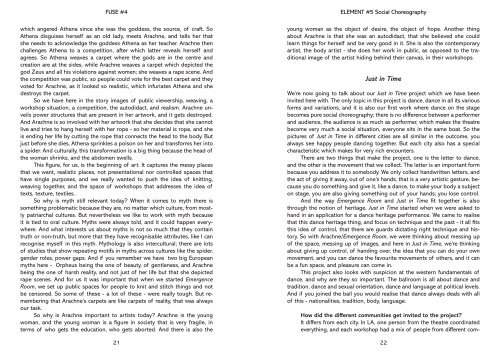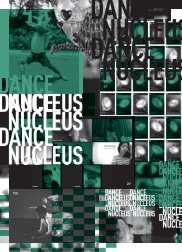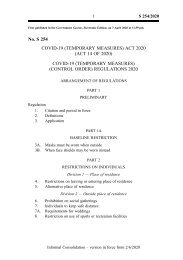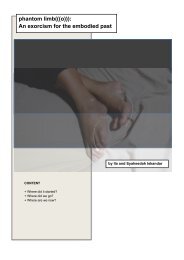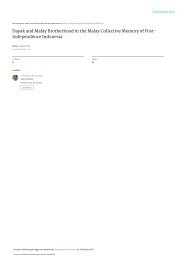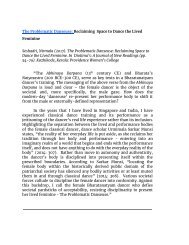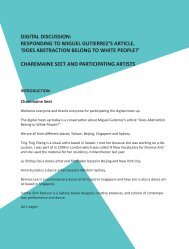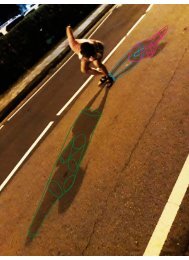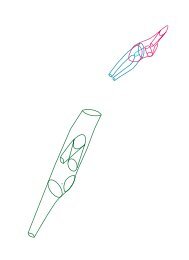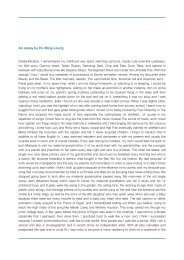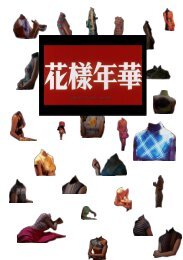FUSE#4
FUSE is a bi-annual publication that documents the projects at Dance Nucleus .
FUSE is a bi-annual publication that documents the projects at Dance Nucleus .
You also want an ePaper? Increase the reach of your titles
YUMPU automatically turns print PDFs into web optimized ePapers that Google loves.
FUSE #4<br />
which angered Athena since she was the goddess, the source, of craft. So<br />
Athena disguises herself as an old lady, meets Arachne, and tells her that<br />
she needs to acknowledge the goddess Athena as her teacher. Arachne then<br />
challenges Athena to a competition, after which latter reveals herself and<br />
agrees. So Athena weaves a carpet where the gods are in the centre and<br />
creation are at the sides, while Arachne weaves a carpet which depicted the<br />
god Zeus and all his violations against women; she weaves a rape scene. And<br />
the competition was public, so people could vote for the best carpet and they<br />
voted for Arachne, as it looked so realistic, which infuriates Athena and she<br />
destroys the carpet.<br />
So we have here in the story images of public viewership, weaving, a<br />
workshop situation, a competition, the autodidact, and realism. Arachne unveils<br />
power structures that are present in her artwork, and it gets destroyed.<br />
And Arachne is so involved with her artwork that she decides that she cannot<br />
live and tries to hang herself with her rope - so her material is rope, and she<br />
is ending her life by cutting the rope that connects the head to the body. But<br />
just before she dies, Athena sprinkles a poison on her and transforms her into<br />
a spider. And culturally, this transformation is a big thing because the head of<br />
the woman shrinks, and the abdomen swells.<br />
This figure, for us, is the beginning of art. It captures the messy places<br />
that we want, realistic places, not presentational nor controlled spaces that<br />
have single purposes, and we really wanted to push the idea of knitting,<br />
weaving together, and the space of workshops that addresses the idea of<br />
texts, texture, textiles.<br />
So why is myth still relevant today? When it comes to myth there is<br />
something problematic because they are, no matter which culture, from mostly<br />
patriarchal cultures. But nevertheless we like to work with myth because<br />
it is tied to oral culture. Myths were always told, and it could happen everywhere.<br />
And what interests us about myths is not so much that they contain<br />
truth or non-truth, but more that they have recognisable attributes, like I can<br />
recognise myself in this myth. Mythology is also intercultural; there are lots<br />
of studies that show repeating motifs in myths across cultures like the spider,<br />
gender roles, power gaps. And if you remember we have two big European<br />
myths here - Orpheus being the one of beauty, of gentleness, and Arachne<br />
being the one of harsh reality, and not just of her life but that she depicted<br />
rape scenes. And for us it was important that when we started Emergence<br />
Room, we set up public spaces for people to knit and stitch things and not<br />
be censored. So some of these - a lot of these - were really tough. But remembering<br />
that Arachne’s carpets are like carpets of reality, that was always<br />
our task.<br />
So why is Arachne important to artists today? Arachne is the young<br />
woman, and the young woman is a figure in society that is very fragile, in<br />
terms of who gets the education, who gets aborted. And there is also the<br />
ELEMENT #5 Social Choreography<br />
young woman as the object of desire, the object of hope. Another thing<br />
about Arachne is that she was an autodidact, that she believed she could<br />
learn things for herself and be very good in it. She is also the contemporary<br />
artist, the body artist - she does her work in public, as opposed to the traditional<br />
image of the artist hiding behind their canvas, in their workshops.<br />
Just in Time<br />
We’re now going to talk about our Just in Time project which we have been<br />
invited here with. The only topic in this project is dance, dance in all its various<br />
forms and variations, and it is also our first work where dance on the stage<br />
becomes pure social choreography; there is no difference between a performer<br />
and audience, the audience is as much as performer, which makes the theatre<br />
become very much a social situation, everyone sits in the same boat. So the<br />
pictures of Just in Time in different cities are all similar in the outcome, you<br />
always see happy people dancing together. But each city also has a special<br />
characteristic which makes for very rich encounters.<br />
There are two things that make the project, one is the letter to dance,<br />
and the other is the movement that we collect. The letter is an important form<br />
because you address it to somebody. We only collect handwritten letters, and<br />
the act of giving it away, out of one’s hands, that is a very artistic gesture, because<br />
you do something and give it, like a dance, to make your body a subject<br />
on stage, you are also giving something out of your hands; you lose control.<br />
And the way Emergence Room and Just in Time fit together is also<br />
through the notion of heritage. Just in Time started when we were asked to<br />
hand in an application for a dance heritage performance. We came to realise<br />
that this dance heritage thing, and focus on technique and the past - it all fits<br />
this idea of control, that there are guards dictating right technique and history.<br />
So with Arachne/Emergence Room, we were thinking about messing up<br />
of the space, messing up of images, and here in Just in Time, we’re thinking<br />
about giving up control, of handing over, the idea that you can do your own<br />
movement, and you can dance the favourite movements of others, and it can<br />
be a fun space, and pleasure can come in.<br />
This project also looks with suspicion at the western fundamentals of<br />
dance, and why are they so important. The ballroom is all about dance and<br />
tradition, dance and sexual orientation, dance and language at political levels.<br />
And if you joined the ball you would realise that dance always deals with all<br />
of this - nationalities, tradition, body, language.<br />
How did the different communities get invited to the project?<br />
It differs from each city. In LA, one person from the theatre coordinated<br />
everything, and each workshop had a mix of people from different com-<br />
21 22


